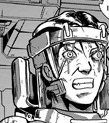Well, ma'am, it's a lot quicker than the old way, that's for sure. That's progress.
God save me from progress!"
- L. Z. Breanne and Jon Littlefield discussing neurally resocialized marine Ardo Melnikov(src)
Neural resocialization is a process, devised by the Terran Confederacy, used to treat criminals suffering from mental disorders or at least prevent them from committing crimes. The process usually involves sentencing the criminals into the military.[1] A number of mercenaries, such as Marcus Wright, have also undergone the experience as a result of having committed brutal crimes.[2] Those who undergo the process often have a blissful look.[3]
Terrans sometimes refer to neural resocialization simply as "resoc"[2] or "brain panning"[4] (the latter term also refers to any form of insanity, brain damage, drug use or even simple stupidity).[5]
Neural resocialization bears many similarities to the technology used to control ghosts.[6]
Resocialized characters' minds are "fuzzy" when sensed by a telepath.[2]
History
- Jim Raynor observed resoc marine behavior on Turaxis II(src)
Neural resocialization was commonly used as early as 2478 by the Terran Confederacy and was sometimes publicly disclosed[7] but was still considered new, "unproved" technology c. 2480.[6] By 2488 it still wasn't common knowledge within the Confederate military[8] and other factions resorted to torturing Confederate soldiers to learn more about it.[9]
The science has continuously advanced since then, having "new" forms by 2499.[4][10] Dominion scientist Dr. Stanley Burgess further advanced the frontier of resocialization.[11]
During the tenure of the Terran Confederacy, most marines were resocialized, but near its end it claimed that only half of its marines were resocialized, "sometimes less".[4] During the Great War, forced resocialization was used to conscript civilians into the military.[10] In the aftermath of the Brood War, the intake of resocialized marines has fallen slightly, but volunteer numbers remained low, so the process has continued.[12] The Dominion's official stance is that its resocialization program is for taking criminals and "redeeming" them, giving them hope and a "new beginning."[3]
Programming
- A "liberated" Marcus Wright(src)
There are multiple types of neural resocialization, but all share two things in common: they reshape the victim's memories (layering new memories over the old ones), and they enforce obedience (to different levels, depending on the type of resocialization). Neurally resocialized soldiers can shift loyalties if their commanders do so as well.[4][2]
The memory layering is "programmed"; the scientists "seek out" and "suppress" certain memories, such as emotionally charged violent criminal memories, covering them with "chocolate-coated" filler memories.[2]
Victims of some forms of resocialization are incapable of even pointing their weapon at another marine.[2][4]
People may gain technical and combat skills during resocialization by receiving experience through altered or new memories. New personnel may be trained quickly in this manner.[10]
Methods of Resocialization
By the beginning of the Great War, the Terran Confederacy used "non-invasive" forms of neural resocialization. These left few physical outward marks (such as divots behind the ear). The process modified behavior such that a resocialized individual was susceptible to obeying strongly given orders even those not in the chain of command. When combined with stimulants, a resocialized marine could be ordered to shoot civilians and relatives; explicit orders were needed to shoot possible "friendlies".[4]
Resocialization tanks provided a "milder" form of resocialization. A subject endured multiple sessions in the tanks where they were "programmed" with knowledge and skills needed for the desired occupation. The procedure tended to leave the subject disoriented for a period of time afterward. The subject emerged with fewer behavioral restrictions; the subject could choose to disobey orders and even attack allies, based on the situation as evaluated by the individual.[10]
Experimentation

Intense resocialization
More intensive forms of resocialization were considered to be extremely painful.[2] Dr. Stanley Burgess, a resocialization specialist for the Terran Dominion used such techniques, sometimes incorporating full-body restraints into the process.[11]
Subconscious resocialization
By 2502 a "subconscious" form of neural resocialization had been developed[13] using resocialization tank technology.[9] While it would cause behavior problems, it would generally have little effect on the victim's personality until a programmed trigger was set off.[13] It could be resisted through willpower.[9]
Faults
- A "liberated" Marcus Wright(src)
Neural resocialization is not restricted to enlisted personnel; Lieutenant Emily Swallow of Alpha Squadron had undergone the process.[4] Notably, a number of obvious candidates have not undergone the process, such as Major Esmerelda Ndoci.[5]
Resocialized soldiers possess little or no initiative, often react poorly to changing battlefield conditions and tend to lack the depth of personality one might find in an ordinary human.[7] Unique talents and expertise are largely wiped away, which resulted in programs such as the War Pigs. However, some handlers preferred "obedient" over "improvisational".[14]
Neural resocialization can "shatter" under stress. For instance, when the resocialized marine Lt. Emily Swallow faced stress when questioning a Sons of Korhal agitator, she had to use her StimPack to "relieve" the stress after the encounter. Later on, her previous criminal behavior came to the fore when she was attacked by zerg.[4] Trauma can also weaken the hold resocialization places on scrubbed memories. To counter this, the Confederate Marine Corps kept seriously wounded resocs heavily sedated whilst undergoing medical treatment in order to prevent them from sliding back into their former personalities.[7]
The Terran Dominion has discovered marine recruits who couldn't be tamed by resocialization as far back as 2499, and created the Reaper Corps for them. Reapers are chemically altered to make them even more aggressive, but are offered two year indentured terms (rather than a lifetime of resocialization). However, not a single reaper has survived six months within the Corps.[15]
A number of protoss have shown the ability to psionically reverse the process of resocialization.[2][11] Even terran psychics can undo the process to an extent.[10]
List of Resocialized Individuals
- Main article: Resocialized characters
References
|
